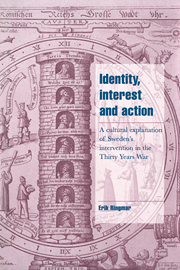 Identity, Interest and Action
Identity, Interest and Action Book contents
- Frontmatter
- Contents
- List of illustrations
- Acknowledgements
- Introduction: the beginning of the story
- Part I A narrative theory of action
- 1 Historical and scientific explanations
- 2 The modern orthodoxy
- 3 A narrative theory of action
- Part II Why did Sweden go to war in 1630?
- Conclusion: the end of the story?
- Notes
- Bibliography
- Index
3 - A narrative theory of action
Published online by Cambridge University Press: 21 October 2009
- Frontmatter
- Contents
- List of illustrations
- Acknowledgements
- Introduction: the beginning of the story
- Part I A narrative theory of action
- 1 Historical and scientific explanations
- 2 The modern orthodoxy
- 3 A narrative theory of action
- Part II Why did Sweden go to war in 1630?
- Conclusion: the end of the story?
- Notes
- Bibliography
- Index
Summary
In this chapter we will look for a way to solve the puzzles which the previous chapter documented: the modern orthodoxy must be given a heterodox reformulation. Perhaps we could call this alternative statement a ‘narrative theory of action’ by virtue of the crucial role it accords to narrative. It is through the stories that we tell that we make sense of ourselves and our world, and it is on the basis of these stories that we act. As I will argue, a study of narrative allows us not only to reconceptualise the notion of interests, but it also puts the modern subject – both the individual and the state – on a more acceptable ontological footing. In addition, narrative provides us with a causal mechanism through which the detached realm of thought can come to be connected to the dynamic realm of action.
Making sense
Let us begin by stressing the importance of meaning in human affairs. While the natural world in and of itself contains no meanings, the social world emphatically does – ultimately it is meaning which separates us from nature. Meaning is also what constitutes the difference between an ‘action’ and a ‘behaviour’. While even robots can behave, only human beings can properly be said to act since only human beings have purposes, intentions and goals.
- Type
- Chapter
- Information
- Identity, Interest and ActionA Cultural Explanation of Sweden's Intervention in the Thirty Years War, pp. 66 - 92Publisher: Cambridge University PressPrint publication year: 1996
